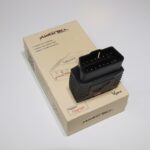A check engine light can be frustrating, especially if you own a Chevy. Understanding what’s triggering that warning light is crucial, but what if you don’t have an OBD2 scanner? This guide will show you how to read Chevy OBD2 codes without a scanner. We’ll cover various methods, from using your odometer to employing a simple paperclip.
Understanding Your Chevy’s Check Engine Light
Your Chevy, like most modern vehicles, uses an onboard diagnostic system (OBD-II) to monitor engine performance and emissions. When a problem is detected, the system stores a Diagnostic Trouble Code (DTC), commonly known as an OBD2 code, and illuminates the check engine light. The light’s behavior can indicate the severity of the issue:
- Solid Yellow/Orange: Indicates a non-emergent issue that requires attention. You can likely drive for a short period, but it’s essential to diagnose the problem soon.
- Solid Red: Signals a more serious problem that requires immediate attention. Avoid driving and have your Chevy diagnosed by a professional.
- Flashing Red: This signifies a critical issue, often a misfire, that can cause severe engine damage. Pull over immediately and do not drive the vehicle.
Reading Chevy OBD2 Codes Without a Scanner
While a scanner is the easiest way to read OBD2 codes, there are alternative methods for your Chevy:
Method 1: Using Your Odometer
Some Chevy models allow you to retrieve codes using the odometer:
- Press and hold the odometer’s trip and reset buttons simultaneously.
- While holding the buttons, turn the ignition to the “On” position (don’t start the engine).
- Release the buttons. The odometer display may show diagnostic trouble codes. If not, try the next method.
Method 2: Ignition Key Cycling
This method involves cycling the ignition key:
- Press and hold the odometer’s trip and reset buttons.
- Turn the ignition “On,” then “Off,” then “On” again without starting the engine.
- Release the buttons. The codes may appear on the odometer display.
Method 3: Observing the Check Engine Light (OBD-I Systems)
Older Chevy models with OBD-I systems use flashing check engine lights to communicate codes:
- Turn the ignition “On” and “Off” several times, ending with the ignition “On.”
- Observe the check engine light. It will flash a series of long and short pulses representing the code. Count the flashes to decipher the code. Refer to an OBD-I code chart specific to your Chevy model year.
Method 4: Using a Paperclip (OBD-I Systems)
For OBD-I systems, you can use a paperclip to jump specific terminals on the diagnostic port:
- Locate the diagnostic port under the dashboard.
- Identify the appropriate terminals for reading codes (consult your vehicle’s repair manual).
- With the ignition off, use a paperclip to connect the terminals.
- Turn the ignition “On” and observe the flashing check engine light as described in Method 3.
Method 5: Seeking Professional Help
If the above methods don’t work or you’re unsure about interpreting the codes, it’s best to consult a professional mechanic. They have the necessary tools and expertise to accurately diagnose and repair your Chevy.
Conclusion
Reading Chevy OBD2 codes without a scanner can be helpful in identifying potential issues. However, remember these methods may not be as reliable or comprehensive as using a scanner. If you encounter a persistent check engine light or are unsure about the diagnosis, always seek professional assistance. Regular maintenance and timely repairs are crucial for keeping your Chevy running smoothly and avoiding costly problems down the road.

